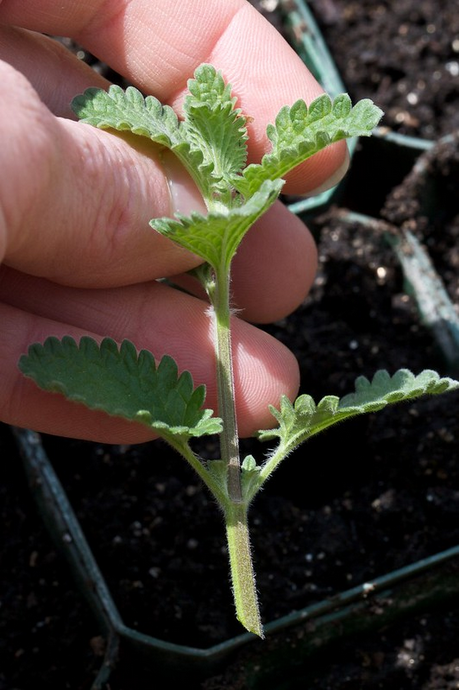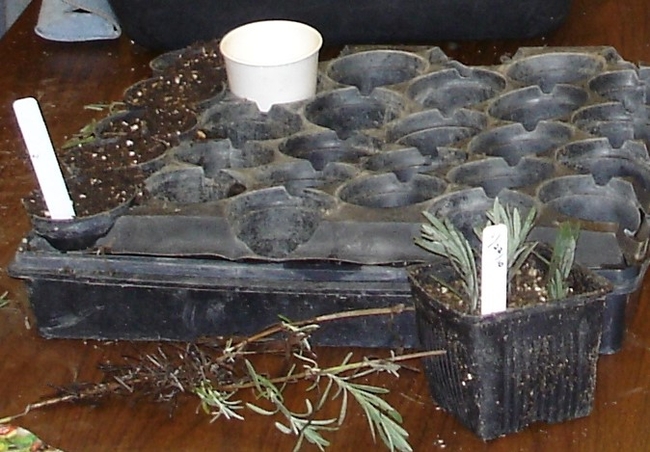My daughter gave me a wonderful, scented geranium (Pelargonium graveolens) for Mother's Day several years ago. It flourishes on my side porch, and I repot it regularly. I like it so much that I have rooted sprigs of that plant and given them as gifts. These new plants are clones of the parent geranium, genetically identical to it.
I do my homestyle cloning the lazy way. I snip off a leafy stem, stick it in a jar of water and wait for roots to appear. I try to remember to change the water every other day. The small glass milk bottles from Straus Family Creamery are perfect for rooting cuttings. The narrow neck of the vessel supports the stem, and the wide bottom magnifies whatever is happening below the water.
The sprig should be between 4 and 6 inches long. I pull the flowers and most of the leaves off, retaining enough leaves to conduct photosynthesis but not so many that they will sap energy and carbohydrates that should be producing roots.
Before I put the cutting in water or plant it, I make a couple of tiny nicks with a clean razor blade just below the node of the cutting. This is the part of the stem that bulges slightly and produces leaves. By nicking it, I am making it easier for the stem to produce roots. It requires a steady hand, so don't do it when you are distracted.
However, there are other ways to propagate favorite plants.
You can find cloning devices for the home gardener at garden shops or online. They aren't terribly expensive, and they typically have space for 24 clones. Another advantage is that they recirculate the water. However, they need a designated space near an electrical outlet, so I make do with windowsills, counters and an array of jars and flowerpots.
Another cloning method is to fill a 6-inch pot with soilless planting mix and poke a deep hole in it with a chopstick or pencil. Then dip your cutting in rooting hormone (available at nurseries), insert the cutting in the hole and press the potting medium around the stem. Water the plant and place a small plastic bag over it to keep the plant hydrated. Keep the bag loose; you don't want condensation to form.
Put the cutting where it will get gentle sunlight. Direct southern exposure all day would be too hot. The cutting should be rooted in a couple of weeks.
A soilless mix is recommended for propagation because it is free of pathogens that might kill the cutting before it roots. You can buy a mix at a nursery or create your own from two parts coir, one part vermiculite and one part perlite.
Cloning plants works because all plants have a meristem, a type of tissue that contains cells that can turn into different plant parts. You can also reproduce many plants from seed, but it's fun to take a cutting from a plant with sentimental value and pass it on.
You can take cuttings from herbaceous plants such as gardenias, dahlias, and pelargoniums at any time of year. My geranium cuttings have been in jars of water for two weeks and are starting to grow roots. These roots are tender, so I won't do the chopstick trick when I plant them. Instead, I will spread the roots gently and cover them carefully with soil.
Geraniums and pelargoniums can be propagated all year long in Napa Valley. Both originated in South Africa but are hardy in our climate. I have a couple in the ground that are four feet tall. Bees love them.
You can use the leaves of scented geraniums (which have a stronger scent than the flowers) in cookery. Add a few rose geranium or apple geranium leaves to an apple pie or pound cake or freeze them in ice cubes for cold drinks.
In a future column, I will describe how to root and graft other types of plants. Rooting your own plants is economical and satisfyingly self-sufficient.
Library Talk: Join UC Master Gardeners of Napa County and the Napa Library for “Discover the Las Flores Learning Garden” on Thursday, January 4, from 7 pm to 8 pm via Zoom. Did you know that Napa has an amazing learning garden where you and your family can see examples of dry gardens, native plants, and pollinator plants? Learn how Master Gardeners transformed part of Las Flores Community Center Park into an array of botanical teaching gardens.
Register Here to receive the Zoom link.Workshop: Join UC Master Gardeners of Napa County for “Winter Rose Garden Care & Pruning,” on Saturday, January 6, from 10 am to noon via Zoom. Prepare your roses for the upcoming growing season with this review of pruning techniques and best pruning tools. Learn how to help your roses cope with climate change and how to choose the right rose for the right place. Attendees will be invited to join a hands-on pruning workshop at Napa's Fuller Park rose garden on Thursday, January 11, from 10 am to noon, to practice what they learned. Register to receive the Zoom link.
Help Desk: The Master Gardener Help Desk is available to answer your garden questions on Mondays and Fridays from 10 am until 1 pm at the University of California Cooperative Extension Office, 1710 Soscol Avenue, Suite 4, Napa. Or send your questions to mastergardeners@countyofnapa.org. Include your name, address, phone number and a brief description.

